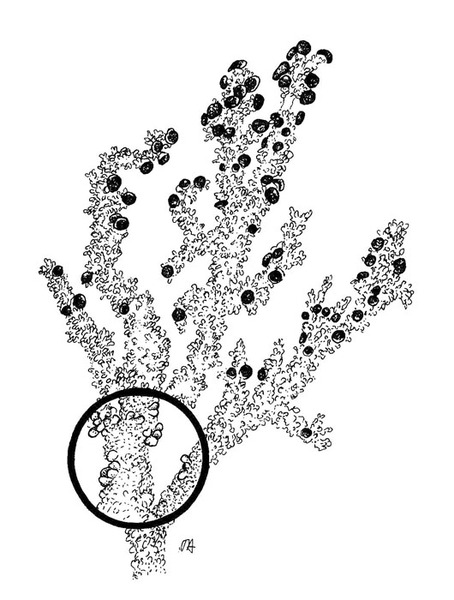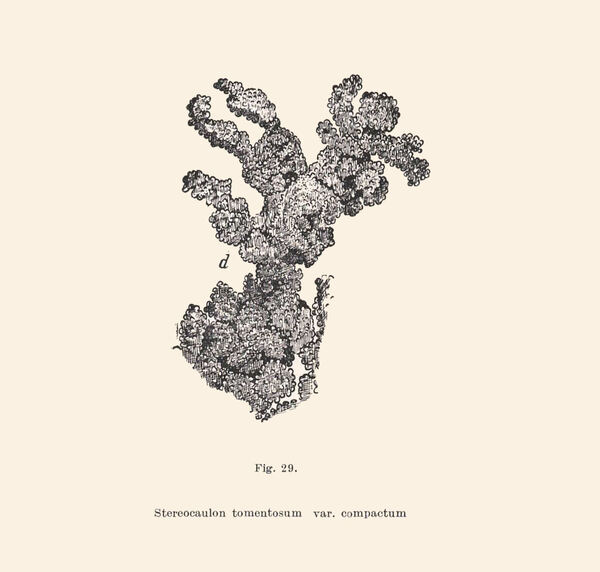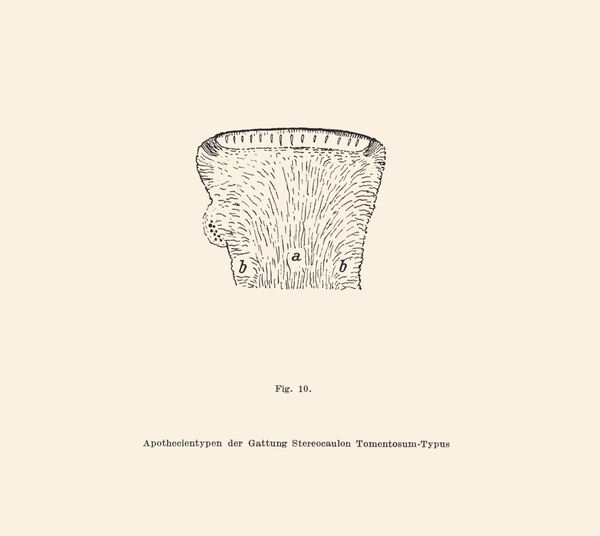Stereocaulon tomentosum Fr.
Sched. Crit., 3: 20, 1825.
Synonyms: Stereocaulon botryocarpum H. Magn.; Stereocaulon cupriniforme Nyl.; Stereocaulon tomentosum var. campestre Körb.
Description: Primary thallus crustose, ephemeral, usually absent in mature individuals, secondary thallus fruticose. Pseudopodetia loosely attached, prostrate to ascending, up to 4(-8) cm tall, 1-2 mm thick, clearly dorsiventral, thickly grey-tomentose especially on lower surface, with a solid cartilaginous axis of parallel hyphae surrounded by a lax medulla. Phyllocladia abundant, granulose to squamulose, ash-grey, mostly rounded and flattened, often overlapping. Cephalodia inconspicuous, more or less spherical, to 0.7 mm across (usually less), embedded in the tomentum of the underside, with Nostoc. Apothecia frequent, mainly located on lateral branches, up to 0.7(-1.2) mm across, with a dark brown to blackish brown, convex disc and an indistinct margin. Proper exciple brown in outer part, colourless within; epithecium brown, K-; hymenium colourless, 45-55 µm high; paraphyses simple, 1.5-1.8 µm thick, the apical cells 3-4 µm wide, with a dark cap; hypothecium colourless. Asci 8-spored, cylindrical-clavate, with a K/I+ blue outer layer and apical dome, and a central, K/I+ darker blue tube, Porpidia-type. Ascospores 3(-6)-septate, hyaline, fusiform, 20-50 x (2.5-)3-4 µm. Pycnidia rare, dark, immersed. Conidia 1-celled, hyaline, straight, 4-5 x c. 0.8 µm. Main photobiont chlorococcoid. Spot tests: K+ yellow, C-, KC-, P+ orange, UV-. Chemistry: atranorin, stictic acid and variable amounts of norstictic acid.
Growth form: Fruticose
Substrata: soil, terricolous mosses, and plant debris
Photobiont: green algae other than Trentepohlia (primary); cyanobacteria, filamentous (e.g. Nostoc, Scytonema) (secundary, e.g. in cephalodia)
Reproductive strategy: mainly sexual
Commonnes-rarity: (info)
Alpine belt: extremely rare
Subalpine belt: rare
Montane belt: very rare
Dry submediterranean belt: absent
Humid submediterranean belt: absent
Padanian area: absent
pH of the substrata:
1 2 3 4 5
Solar irradiation:
1 2 3 4 5
Aridity:
1 2 3 4 5
Eutrophication:
1 2 3 4 5
Poleotolerance:
0 1 2 3
Altitudinal distribution:
1 2 3 4 5 6
Rarity
absent
extremely rare
very rare
rare
rather rare
rather common
common
very common
extremely common
Loading data...
Occurrence data
Predictive map
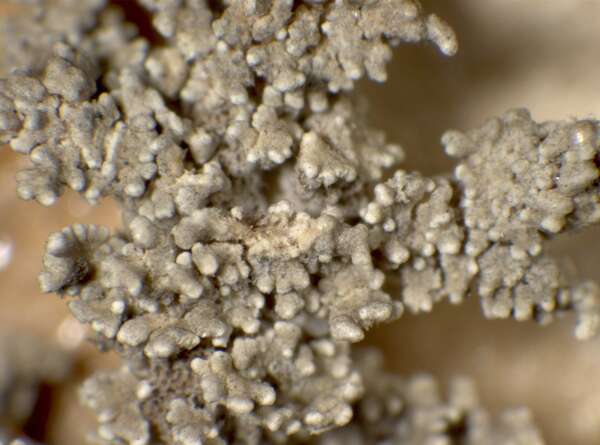
P.L. Nimis; Owner: Department of Life Sciences, University of Trieste
Herbarium: TSB (27699)
2001/12/11
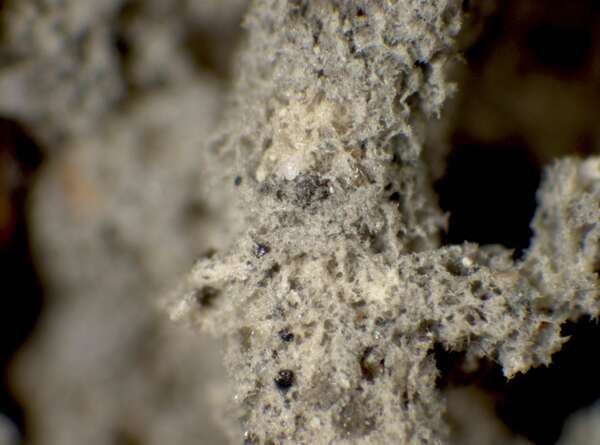
P.L. Nimis; Owner: Department of Life Sciences, University of Trieste
Herbarium: TSB (27699)
2001/12/11
tomentum on main branch
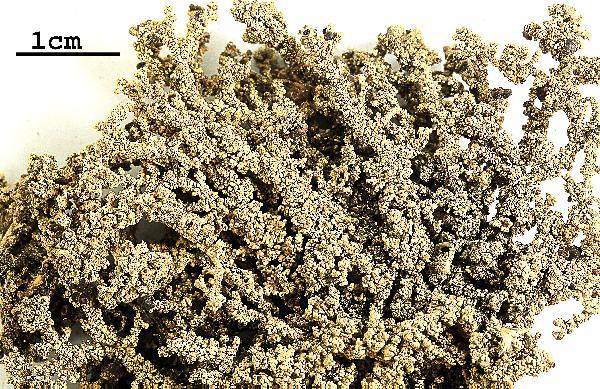
Felix Schumm - CC BY-SA 4.0
[LN444], Ecuador. Cotopaxi. Zwischen Pujilí und Zumbahua, westlich
von Latacunga. An freistehenden Granitfelswänden. 3800 m. Leg. K. &
A. Kalb 13.08.1987, det. H. Sipman. Ex K. KALB: LICHENES NEOTROPICI
NR. 444.

Felix Schumm - CC BY-SA 4.0
[VZ1283], Bohemoslovacia. Slovacia, Carpates, montes Slovenské
Rudohorie: Miníšek, in valle rivi Smolník prope Smolnická pila, 500
m. Ad scorias vetustas. Leg. A. Kiszely & A. V zda, 21.07.1974, det.
M. I. Lamb.- Annot.: "Pro Monogr Stereoc. Univ. sumptum, no. 10177,
M. I. Lamb in litt.- Ex A. V ZDA: LICHENES SELECTI EXSICCATI NR.
1283.

Felix Schumm - CC BY-SA 4.0
[LN444], Ecuador. Cotopaxi. Zwischen Pujilí und Zumbahua, westlich
von Latacunga. An freistehenden Granitfelswänden. 3800 m. Leg. K. &
A. Kalb 13.08.1987, det. H. Sipman. Ex K. KALB: LICHENES NEOTROPICI
NR. 444.
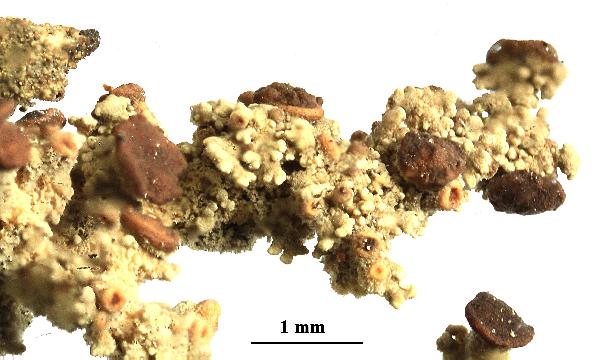
Felix Schumm - CC BY-SA 4.0
[VZ1283], Bohemoslovacia. Slovacia, Carpates, montes Slovenské
Rudohorie: Miníšek, in valle rivi Smolník prope Smolnická pila, 500
m. Ad scorias vetustas. Leg. A. Kiszely & A. V zda, 21.07.1974, det.
M. I. Lamb.- Annot.: "Pro Monogr Stereoc. Univ. sumptum, no. 10177,
M. I. Lamb in litt.- Ex A. V ZDA: LICHENES SELECTI EXSICCATI NR.
1283.
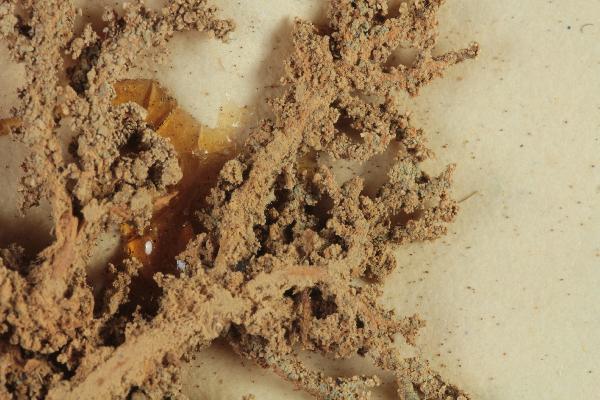
Collezione lichenologica Abramo Massalongo del Museo di Storia Naturale G. Ligabue di Venezia - Autori: Seggi, Linda; Trabucco, Raffaella Proprietà: Fondazione Musei Civici di Venezia - CC BY-NC
Italia, Veneto, in m. Pelmo 1855
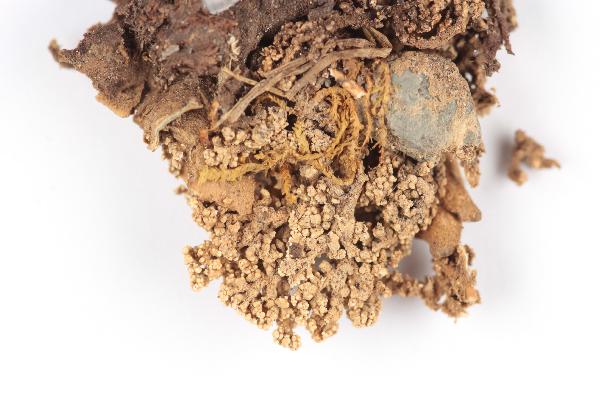
Collezione lichenologica Abramo Massalongo del Museo di Storia Naturale G. Ligabue di Venezia - Autori: Seggi, Linda; Trabucco, Raffaella Proprietà: Fondazione Musei Civici di Venezia - CC BY-NC
Italia, Veneto, in Alp. Cadubriae
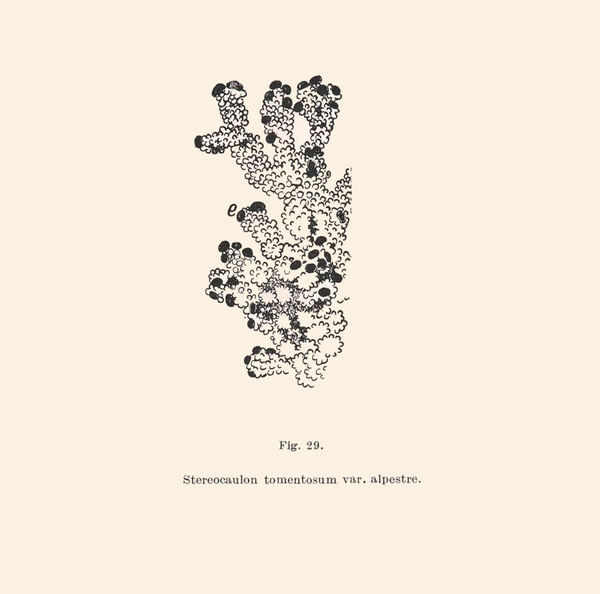
Frey E. 1933. Cladoniaceae (unter Ausschluß ded Gattung Cladonia) und Umbilicariaceae. In: Rabenhrst’s Kryptogamenflora von Deutschland, Österreich und der Schweiz. 15: 1-208.
var. alpestre
Growth form: Fruticose
Substrata: soil, terricolous mosses, and plant debris
Photobiont: green algae other than Trentepohlia (primary); cyanobacteria, filamentous (e.g. Nostoc, Scytonema) (secundary, e.g. in cephalodia)
Reproductive strategy: mainly sexual
Commonnes-rarity: (info)
Alpine belt: extremely rare
Subalpine belt: rare
Montane belt: very rare
Dry submediterranean belt: absent
Humid submediterranean belt: absent
Padanian area: absent
pH of the substrata:
| 1 | 2 | 3 | 4 | 5 |
Solar irradiation:
| 1 | 2 | 3 | 4 | 5 |
Aridity:
| 1 | 2 | 3 | 4 | 5 |
Eutrophication:
| 1 | 2 | 3 | 4 | 5 |
Poleotolerance:
| 0 | 1 | 2 | 3 |
Altitudinal distribution:
| 1 | 2 | 3 | 4 | 5 | 6 |
Rarity
absent
extremely rare
very rare
rare
rather rare
rather common
common
very common
extremely common
Loading data...
Occurrence data
Predictive map

P.L. Nimis; Owner: Department of Life Sciences, University of Trieste
Herbarium: TSB (27699)
2001/12/11

P.L. Nimis; Owner: Department of Life Sciences, University of Trieste
Herbarium: TSB (27699)
2001/12/11
tomentum on main branch

Felix Schumm - CC BY-SA 4.0
[LN444], Ecuador. Cotopaxi. Zwischen Pujilí und Zumbahua, westlich von Latacunga. An freistehenden Granitfelswänden. 3800 m. Leg. K. & A. Kalb 13.08.1987, det. H. Sipman. Ex K. KALB: LICHENES NEOTROPICI NR. 444.

Felix Schumm - CC BY-SA 4.0
[VZ1283], Bohemoslovacia. Slovacia, Carpates, montes Slovenské Rudohorie: Miníšek, in valle rivi Smolník prope Smolnická pila, 500 m. Ad scorias vetustas. Leg. A. Kiszely & A. V zda, 21.07.1974, det. M. I. Lamb.- Annot.: "Pro Monogr Stereoc. Univ. sumptum, no. 10177, M. I. Lamb in litt.- Ex A. V ZDA: LICHENES SELECTI EXSICCATI NR. 1283.

Felix Schumm - CC BY-SA 4.0
[LN444], Ecuador. Cotopaxi. Zwischen Pujilí und Zumbahua, westlich von Latacunga. An freistehenden Granitfelswänden. 3800 m. Leg. K. & A. Kalb 13.08.1987, det. H. Sipman. Ex K. KALB: LICHENES NEOTROPICI NR. 444.

Felix Schumm - CC BY-SA 4.0
[VZ1283], Bohemoslovacia. Slovacia, Carpates, montes Slovenské Rudohorie: Miníšek, in valle rivi Smolník prope Smolnická pila, 500 m. Ad scorias vetustas. Leg. A. Kiszely & A. V zda, 21.07.1974, det. M. I. Lamb.- Annot.: "Pro Monogr Stereoc. Univ. sumptum, no. 10177, M. I. Lamb in litt.- Ex A. V ZDA: LICHENES SELECTI EXSICCATI NR. 1283.

Collezione lichenologica Abramo Massalongo del Museo di Storia Naturale G. Ligabue di Venezia - Autori: Seggi, Linda; Trabucco, Raffaella Proprietà: Fondazione Musei Civici di Venezia - CC BY-NC
Italia, Veneto, in m. Pelmo 1855

Collezione lichenologica Abramo Massalongo del Museo di Storia Naturale G. Ligabue di Venezia - Autori: Seggi, Linda; Trabucco, Raffaella Proprietà: Fondazione Musei Civici di Venezia - CC BY-NC
Italia, Veneto, in Alp. Cadubriae




